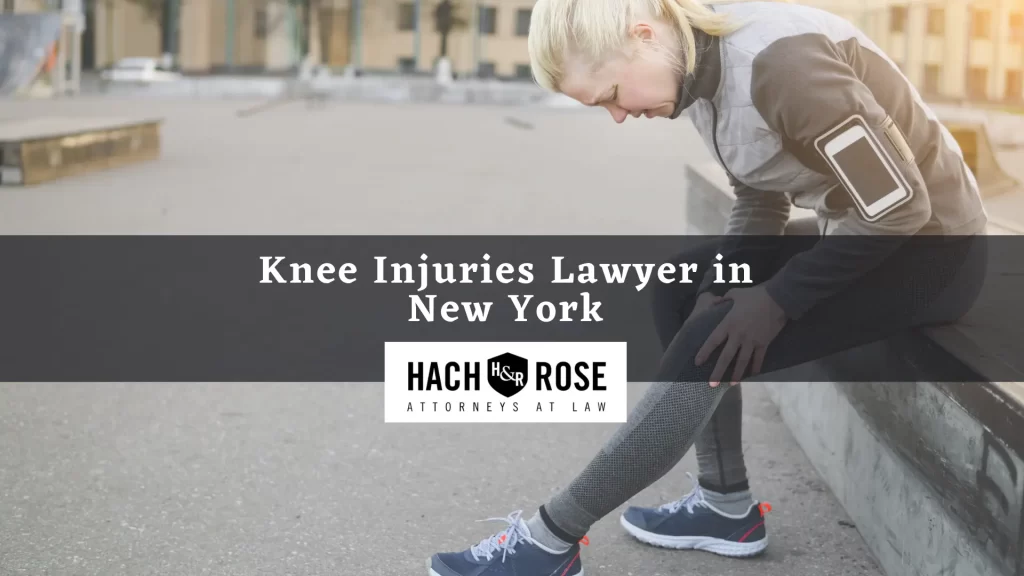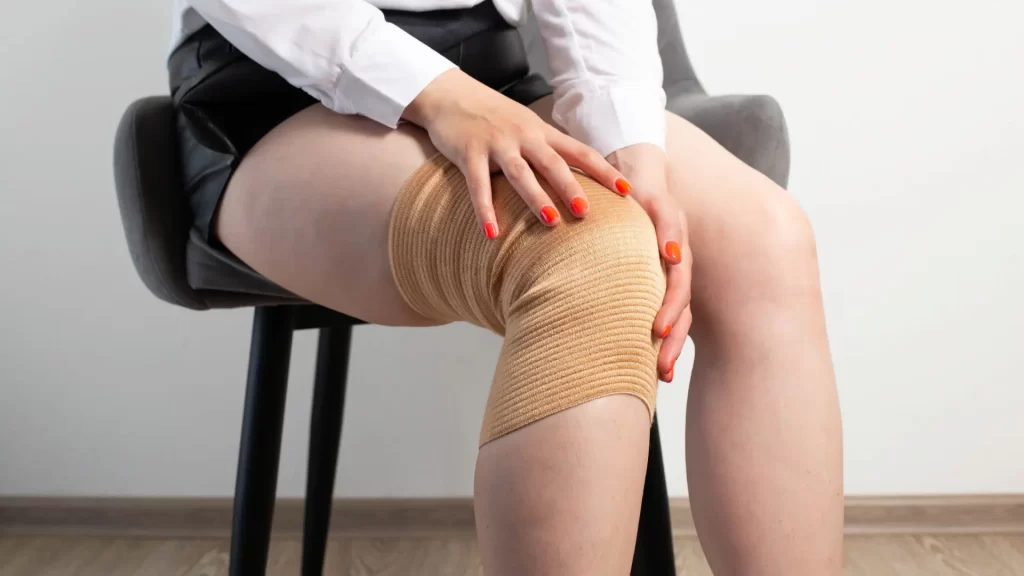
By John Blyth
Knee injuries, while common, can be extremely painful and may interfere with a sufferer’s ability to enjoy normal, everyday activities. There are many types of knee injuries, as well as a variety of causes and treatments. An experienced New York knee injury lawyer can help you if you have suffered knee injuries due to another’s negligence,
Knee injuries may be caused by a fall, motor vehicle accident, repetitive stress on the knee, or overuse. Knee injuries are characterized by pain, swelling, heat, redness, tenderness, a clicking or popping sound, difficulty bending the knee, problems bearing weight, locking the knee, bruising, and instability while standing.
Have you suffered a knee injury due to someone else’s negligence in New York City?
At Hach & Rose, LLP, our personal injury lawyers dedicate our time and attention to representing knee injury victims against the negligence of others. Our client testimonials agree that our legal team supports our clients and has delivered compensation results. Call a New York personal injury attorney at (212) 779-0057 today for a .
Types of Knee Injuries
There are many types of knee injuries sustained by victims, such as sprains, bursitis, hyperflexion or hypertension, meniscus tears, dislocation, and more severe injuries. You may have a knee injury claim if your injury was due to someone else’s, even a company’s, ignorance.
Knee Sprains
A knee sprain occurs when ligament fibers are stretched or torn. Ligaments hold the knee together; they stabilize the knee in movements from front to back and from side to side. There are four different ligaments: the anterior cruciate ligament, posterior cruciate ligament, medial cruciate ligament, and lateral cruciate ligament (ACL, PCL, MCL, and LCL). A sprain is graded by the severity of the stretch/tear to the ligament fibers. A patient diagnosed with a grade one sprain is experiencing pain due to a stretched ligament; however, the fibers are not torn, and the patient is not feeling any instability.
Identifying the Cause of Knee Sprains
Physicians will typically identify a patient’s specific knee problem by examining the patient’s physical activity and accident history and determining the possible cause of the injury. For example, if a marathoner complains of knee pain, the patient is most likely suffering from overuse and repetitive stress and may be diagnosed with patellofemoral pain syndrome, or “runner’s knee.”
Additionally, a doctor may order an X-ray, MRI, or CT scan to identify the location of the injury within the knee. Knee injuries include sprain, strain, bursitis, meniscus tears, knee joint dislocation, and knee fractures.
Grade Two Knee Sprain Injury
A grade two sprain is characterized by partially torn ligament fibers and mild instability. A grade three sprain—the most severe—occurs when a patient experiences severe instability and ligament fibers are torn completely. Knee sprains are often caused by unexpected, unnatural knee movements, such as sudden twisting, changing direction quickly while running, jumping, landing, or a blow to the knee.
Knee Hyperflexion Hypertension
Hyperflexion or hyperextension (when the knee is forced out of its normal range of motion) will typically cause a knee strain. Hyperflexion and hyperextension can occur during sports or high-impact incidents, like a motor vehicle accident, when muscles surrounding the knee, like the patellar tendon, are stretched, causing a strain. This strain leads to pain outside of the knee joint and can cause dysfunction of the normal range of motion of the knee.
Knee Bursitis
Knee bursitis occurs when a bursa, a fluid-filled pouch within the knee, is irritated, inflamed, or infected. Bursas act as a shock absorber and reduce friction between muscles and tendons around the joints. There are two main bursas in the knee. Knee bursitis may occur as a side effect of arthritis, a result of a blow to the knee, frequent and sustained pressure, or a bacterial infection of the bursa.
Meniscus tears
Meniscus tears occur when the interior of the knee is damaged. Medial and lateral menisci are pieces of smooth cartilage that, like the bursas, act as shock absorbers. They provide a cushion for the femur (thigh bone), which can be injured acutely during an accident or simply because of aging and overuse.
Dislocation
Knee joint dislocation occurs due to a high-impact, large-force injury, such as a car accident. This is a rare type of knee injury, but it has the ability to cause traumatic damage to every part of the knee, including blood vessels and nerves. This kind of knee injury requires immediate emergency surgery. Sometimes, the patella (or kneecap) can become dislocated; however, this is much less severe than a knee joint dislocation. The patella can be popped back into place and treated with a splint and/or physical therapy.
Direct blows to the bones of the knee cause knee fractures. The patella may crack when a person suffers a severe fall, landing directly on the knee. In this case, the patella may crack due to the force of the fall.
Causes of Knee Injuries
Knee injuries can be caused by a near-endless list of situations, accidents, and negligences. One thing that is a common factor of knee injury claims is the havoc they wreak on victims’ lives, families, and finances.
Slip and Fall Injuries to the Knees
Slip and fall injuries to the knees are a common and serious concern, often resulting from uneven surfaces, wet floors, or obstacles in walkways. When a person falls, the knees frequently bear the brunt of the impact, leading to injuries such as fractures, ligament tears, or cartilage damage. These injuries can cause significant pain, swelling, and difficulty in movement, potentially requiring medical intervention such as physical therapy or surgery.
Ensuring safe environments by keeping walkways clear, using non-slip materials, and providing adequate lighting can help prevent these accidents. Slip and fall injuries not only cause physical harm but also contribute to lost work time and increased medical expenses.
Motor Vehicle Knee Injuries
Motor vehicle accidents or any high-impact injury may necessitate emergency knee surgery. Voluntary knee replacement surgery may occur when knee pain impedes daily life. This knee pain may be caused by a lifetime of repetitive motion and stress on the knee.
Have you suffered a knee injury in a car accident, motorcycle accident, or truck accident in New York City? Call our legal team and a knee injury lawyer at (212) 779-0057 or contact us online today.
Repetitive Motion Workplace Knee Injury
Repetitive motion knee injuries in the workplace occur when employees perform the same knee-straining tasks over extended periods. This kind of work related knee injury is common in occupations that involve frequent bending, lifting, kneeling, or squatting, such as construction, manufacturing, and warehousing.
The continuous stress placed on the knee joints and surrounding tissues can lead to conditions like tendonitis, bursitis, or patellofemoral pain syndrome. A workplace knee injury can develop gradually. These injuries develop gradually and can significantly impact an employee’s ability to perform their duties, leading to chronic pain, reduced mobility, and, in severe cases, the need for surgical intervention.
Mitigating the Risk of Injury
Employers can mitigate the risk of repetitive motion knee injuries by implementing ergonomic solutions and promoting safe work practices. Providing adjustable workstations, encouraging regular breaks, and offering training on proper lifting techniques can help reduce strain on the knees.
Additionally, incorporating stretching exercises and physical conditioning programs can strengthen the muscles around the knee, improving overall joint stability. By prioritizing these preventive measures, employers can create a safer work environment, reducing the incidence of knee injuries and maintaining a healthy, productive workforce.
Sports injuries
Occasionally, a knee injury is sports-induced. In other cases, a knee injury is caused by a fall, motor vehicle accident, or stress/overuse. In these cases, an outside party may be at fault for the injury. A case involving a knee injury may also involve other injuries, such as injuries to the femur, tibia, and fibula (upper leg and lower leg).

Knee Injury Treatment
If you are experiencing knee pain after an accident or fall, many treatment options are available. A medical professional can help you identify the best course of treatment for your particular situation. The treatment depends on the damaged knee part and the severity of the damage.
R.I.C.E Treatment
If a patient suffers from a simple sprain or strain, most physicians will avoid long-term, expensive treatment and instead advise that the patient rest the knee, place ice on it, compress, and elevate the knee above the heart (R.I.C.E.). There are also a variety of over-the-counter anti-inflammatories available for patients suffering from acute knee injuries. If the knee injury is more severe, a doctor may advise knee immobilization in the form of a splint.
Treatment for Chronic Knee Injury
Chronic knee injuries involving inflammation and bursitis may require cortisone shots. Cortisone is an extremely powerful steroid with strong anti-inflammatory effects, which can help ease the pain caused by a knee injury. Surgery, typically the last resort, may be necessary for torn ligaments, extensive damage to the menisci, or some fractures and dislocations of the knee.
Non-Emergency Surgeries
Most non-emergency surgeries are done arthroscopically. A camera is used in this procedure, and small punctures are made in the knee to insert surgical instruments. This allows repairs to be made inside the knee without actually having to open the knee with a large incision.
Medical professionals typically advise most knee pain patients to visit a physical therapist. Post-operative patients visit the physical therapist and patients for whom surgery is not an option. A physical therapist will lead a patient through various exercises designed to strengthen and stretch the muscles surrounding the knee. This will allow the patient to exercise strengthened leg and knee movement to help prevent further injury.
Contact a New York Knee Injury Attorney
At Hach & Rose, LLP our personal injury attorneys have experience determining liability for knee injuries and obtaining compensation for our injured clients. Call our legal team at (212) 779-0057 or contact us online for a free consultation with a knee injury lawyer. Because we work on a contingency fee basis, you pay nothing unless and until you win your personal injury case.
